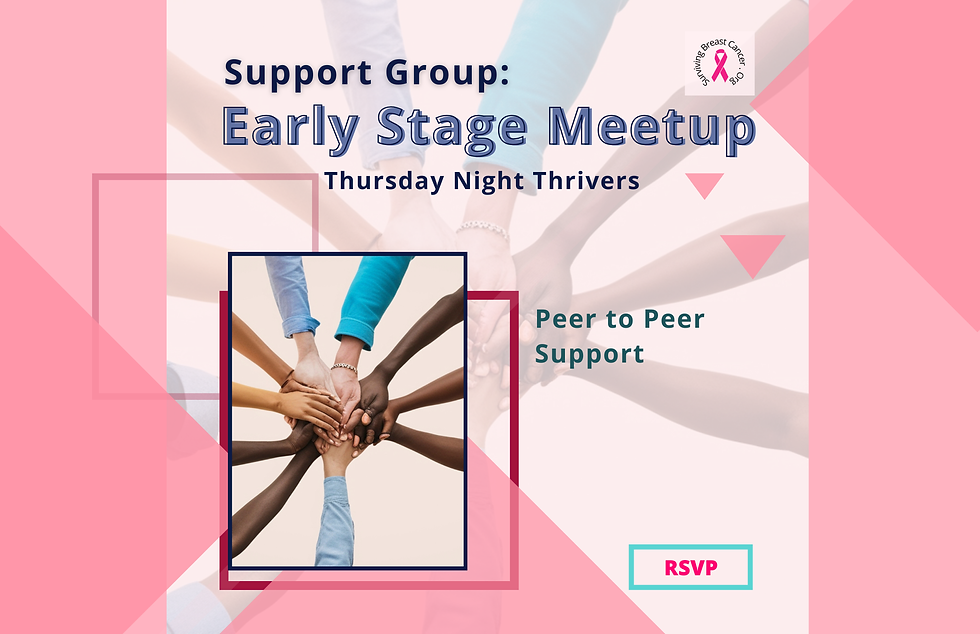Understanding TAILORx
- Surviving Breast Cancer

- Aug 7, 2022
- 4 min read
Updated: Nov 3, 2025
By Rachael Curry
What is the TAILORx Trial?
You may recall when the primary results of the TAILORx study were first released. About two years ago, the New England Journal of Medicine published the following, which SBC covered in a blog post: “The Oncotype DX Breast Recurrence Score® Test Definitively Identifies the 70% of Women with Early-stage Breast Cancer Who Receive No Benefit from Chemotherapy, and the 30% of Women for Whom Chemotherapy Benefit Can be Life-saving.” This news was groundbreaking and very positive! But what exactly does it mean? As the study is still continuing, let’s dive in.
TAILORx, the “Trial Assigning Individualized Options for Treatment (Rx),” first began in March of 2006. Recruiting over 10,000 individuals with breast cancer, it sought to answer the question: Is hormone therapy as a singular treatment inferior to both hormone therapy and chemotherapy in combination?
For some breast cancer patients, the course of treatment was already relatively straightforward. Those who were considered very low risk were often referred to only hormone therapy, while those who were considered very high risk were prescribed both hormone therapy and chemotherapy in combination. But what about those who were considered an intermediate risk? The treatment recommendations varied, lacking thorough data to support either avenue.
Thus began the TAILORx trial: to determine the most effective personalized treatment course for individuals with the most common type of breast cancer, HR positive, HER-2-negative, node-negative breast cancer. The goal was to provide clinicians with the research to supplement data-driven decision-making regarding individualized treatment courses.
This study is supported by the National Cancer Institute (NCI) and led by the ECOG-ACRIN Cancer Research Group. It is scheduled for completion in 2030.

What is HR Positive, HER-2 Negative, Node-Negative Breast Cancer?
The individuals enrolled in the TAILORx trial had varying risk levels of HR positive, HER-2-negative, axillary lymph node-negative breast cancer.
HR positive stands for “hormone receptor positive.” This means that the cancer cells have lots of hormone receptors on them, as opposed to HR negative cells, which have little to no hormone receptors. These receptors allow for the hormones estrogen and progesterone to bind to the cancer cells, which promotes growth. Therefore, HR positive breast cancer has a more rapid growth of cancerous cells than HR negative. About 70-80% of all breast cancers are HR positive.
HER-2 stands for “human epidermal growth factor receptor 2.” HER-2 is also a receptor; however, it is present on all cells, even healthy ones. The difference is that when cancer cells are HER-2 positive, there is an abnormally large number of receptors present, which promotes the rapid growth of cancer cells. Thus, HER-2 positive breast cancer is more likely to metastasize (or spread quickly throughout the body). In this case, HER-2 negative means that there are little to no HER-2 receptors present on the breast cancer cells. Finally, node-negative cancer means that the cancer cells have not spread to the surrounding lymph nodes.
What is an Oncotype DX Tumor Recurrence Score?
When enrolled in the study, the breast cancer patients had their risk level determined on a scale called the Oncotype DX Tumor Recurrence Score. Essentially, this score ranked the risk on a scale of 0-100. Low risk was considered an approximate score of 0-10, intermediate risk 11-25, and high risk 26 or above.
Certain providers, however, evaluate the scores based on slightly different criteria. Therefore, the ranges are not exact, and each individual’s score and risk level should be determined with their provider. Not all providers choose to follow the risk scale when determining treatment.
Further details on how scores are evaluated can be found in the previous SurvivingBreastCancer.org blog post, Oncotype DX Score.
What are the Findings of the TAILORx trial?
Although the TAILORx trial is scheduled to finish in 2030, initial findings have been distributed. Primarily, researchers have found that there is no benefit from chemotherapy for 70% of breast cancer patients with an intermediate risk level on the Oncotype DX scale. In these cases, hormone therapy alone was just as effective as hormone therapy along with chemotherapy. This was determined by comparison of the experimental group of intermediate risk patients, who underwent both hormone therapy and chemotherapy, and the control group of intermediate risk patients, who received only hormone therapy. In the end, both groups showed no improvement in either survival rate or recurrence rate for having undergone additional chemotherapy.
This data will be used to guide clinicians when making decisions about the course of treatment for intermediate-risk breast cancer patients with HR positive, HER-2-negative, node-negative cancer.
Conclusion
Studies such as TAILORx are important because they strive to create data-driven personalized treatment for breast cancer patients. With many potential negative side effects from chemotherapy, it is crucial to know whether it is essential to recovery before deciding to undergo treatment. For those in the intermediate risk pool, the TAILORx research will create important leverage for both clinician decision-making and patient advocacy when determining courses of treatment in the future.
Sources
About the Author:
I am a 2019 graduate of the University of Michigan with a BA in Gender and Health, and a current MPH candidate at Boston University focusing on Healthcare Management. I am interested in the intersection of social identity and women’s reproductive health. In the future, I hope to help create a more accessible and equitable healthcare system for all women. During my free time, I enjoy painting, drawing, running, and hiking.










